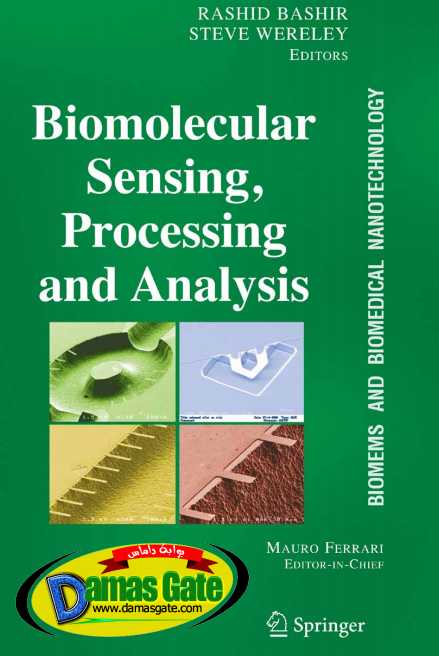Biomolecular Sensing Processing and Analysis - Rashid Bashir and Steve Wereley

Preface
BioMEMS and its extensions into biomedical nanotechnology have tremendous potential
both from a research and applications point of view. Exciting strides are being made at
intersection of disciplines and BioMEMS and biomedical nanotechnology is certainly one
of these very interdisciplinary fields, providing many opportunities of contribution from
researchers from many disciplines. In the specific areas of bimolecular sensing, processing
and analysis, BioMEMS can play a critical role to provide the various technology platforms
for detection of cells, microorganisms, viruses, proteins, DNA, small molecules, etc. and
the means to interface the macroscale realm to the nanoscale realm.
We are very pleased to present volume 4 in the Handbook of BioMEMS and Biomedical
Nanotechnology, published by Kluwer Academic Press. This volume contains 18 chapters
focused on ‘Biomolecular Sensing, Processing and Analysis’, written by experts in the field
of BioMEMS and biomedical nanotechnology. The chapters are groups into three broad
categories of Sensors and Materials, Processing and Integrated Systems, and Microfluidics.
Prof. Taun Vo-Dinh from Oakridge National Labs begins the Sensors and Materials
section by providing a review of biosensors and biochips. This review is followed by an
example of mechanical cantilever sensor work described by Prof. Arun Majumdar’s group
at UC Berkeley and Prof. Tom Thundat at Oakridge National Laboratory. An example of
a nano-scale sensor electrical sensor, an artificial pore, integrated in a microscale device
is presented next by Prof. Lydia Sohn’s group at UC Berkeley. Cell based sensors are an
important class of electrical sensors and Profs. Cengiz Ozkan and Mihri Ozkan at UC
Riverside present a review of their work in this area. These chapters on sensors are followed
by a review chapter on silicon and glass BioMEMS processing by Prof. Nam Trung Nguyen
at Nanyang Technological University. Polymers and hydrogels are an important class of
bioMEMS materials and Profs. Nicholas Peppas at UT Austin and Zach Hilt at University
of Kentucky provide a review chapter in this area to close off this section.
The Processing and Integrated Systems section is focused on means to manipulate
biological and fluidic samples in BioMEMS device and examples of integrated BioMEMS
systems. Prof. Abe Lee from UCIrvine presents a reviewof magnetohydrodynamic methods
and their utility in BioMEMS and micro-total-analysis (µTAS) systems. Dielectrophoresis
(DEP) is being increasing used at the microscale and in BioMEMS applications and Prof.
Download
*

Preface
BioMEMS and its extensions into biomedical nanotechnology have tremendous potential
both from a research and applications point of view. Exciting strides are being made at
intersection of disciplines and BioMEMS and biomedical nanotechnology is certainly one
of these very interdisciplinary fields, providing many opportunities of contribution from
researchers from many disciplines. In the specific areas of bimolecular sensing, processing
and analysis, BioMEMS can play a critical role to provide the various technology platforms
for detection of cells, microorganisms, viruses, proteins, DNA, small molecules, etc. and
the means to interface the macroscale realm to the nanoscale realm.
We are very pleased to present volume 4 in the Handbook of BioMEMS and Biomedical
Nanotechnology, published by Kluwer Academic Press. This volume contains 18 chapters
focused on ‘Biomolecular Sensing, Processing and Analysis’, written by experts in the field
of BioMEMS and biomedical nanotechnology. The chapters are groups into three broad
categories of Sensors and Materials, Processing and Integrated Systems, and Microfluidics.
Prof. Taun Vo-Dinh from Oakridge National Labs begins the Sensors and Materials
section by providing a review of biosensors and biochips. This review is followed by an
example of mechanical cantilever sensor work described by Prof. Arun Majumdar’s group
at UC Berkeley and Prof. Tom Thundat at Oakridge National Laboratory. An example of
a nano-scale sensor electrical sensor, an artificial pore, integrated in a microscale device
is presented next by Prof. Lydia Sohn’s group at UC Berkeley. Cell based sensors are an
important class of electrical sensors and Profs. Cengiz Ozkan and Mihri Ozkan at UC
Riverside present a review of their work in this area. These chapters on sensors are followed
by a review chapter on silicon and glass BioMEMS processing by Prof. Nam Trung Nguyen
at Nanyang Technological University. Polymers and hydrogels are an important class of
bioMEMS materials and Profs. Nicholas Peppas at UT Austin and Zach Hilt at University
of Kentucky provide a review chapter in this area to close off this section.
The Processing and Integrated Systems section is focused on means to manipulate
biological and fluidic samples in BioMEMS device and examples of integrated BioMEMS
systems. Prof. Abe Lee from UCIrvine presents a reviewof magnetohydrodynamic methods
and their utility in BioMEMS and micro-total-analysis (µTAS) systems. Dielectrophoresis
(DEP) is being increasing used at the microscale and in BioMEMS applications and Prof.
Download
*